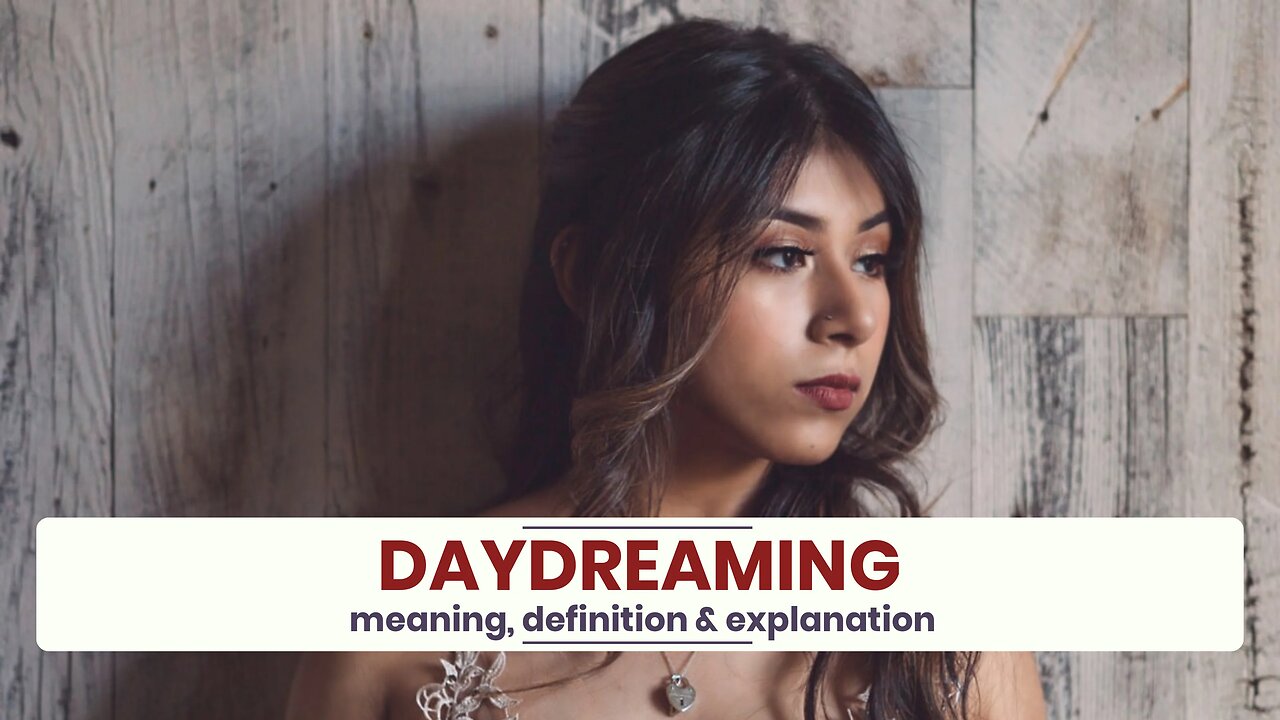Premium Only Content

What is DAYDREAMING?
✪✪✪✪✪
http://www.theaudiopedia.com
✪✪✪✪✪
What does DAYDREAMING mean? DAYDREAMING meaning - DAYDREAMING definition - DAYDREAMING explanation. What is the meaning of DAYDREAMING? What is the definition of DAYDREAMING? What does DAYDREAMING stand for? What is DAYDREAMING meaning? What is DAYDREAMING definition?
Daydreaming is a short-term detachment from one's immediate surroundings, during which a person's contact with reality is blurred and partially substituted by a visionary fantasy, specially one of happy, pleasant thoughts, hopes or ambitions, imagined as coming to pass, and experienced while awake.
There are many types of daydreams, and there is no consistent definition amongst psychologists, however the characteristic that is common to all forms of daydreaming meets the criteria for mild dissociation.
Freudian psychology interpreted daydreaming as expression of the repressed instincts similarly to those revealing themselves in nighttime dreams. Like nighttime dreams, daydreams, also, are an example of wish-fulfilment (based on infantile experiences), and are allowed to surface because of relaxed censorship. He pointed out that, in contrast to nighttime dreams, which are often confusing and incoherent, there seems to be a process of "secondary revision" in fantasies that makes them more lucid, like daydreaming. The state of daydreaming is a kind of liminal state between waking (with the ability to think rationally and logically) and sleeping. They stand in much the same relation to the childhood memories from which they are derived as do some of the Baroque palaces of Rome to the ancient ruins whose pavements and columns have provided the material for the more recent structures.
In the late 1960s, cognitive psychologists Jerome L. Singer of Yale University and John S. Antrobus of the City College of New York, created a daydream questionnaire. The questionnaire, called the Imaginal Processes Inventory (IPI), has been used to investigate daydreams. Psychologists Leonard Giambra and George Huba used the IPI and found that daydreamers' imaginary images vary in three ways: how vivid or enjoyable the daydreams are, how many guilt- or fear-filled daydreams they have, and how "deeply" into the daydream people go.
Humanistic psychology on other hand, found numerous examples of people in creative or artistic careers, such as composers, novelists and filmmakers, developing new ideas through daydreaming. Similarly, research scientists and mathematicians have developed new ideas by daydreaming about their subject areas.
Eric Klinger's research in the 1980s showed that most daydreams are about ordinary, everyday events and help to remind us of mundane tasks. Klinger's research also showed that over 75% of workers in "boring jobs," such as lifeguards and truck drivers, use vivid daydreams to "ease the boredom" of their routine tasks. Klinger found that fewer than 5% of the workers' daydreams involved explicitly sexual thoughts and that violent daydreams were also uncommon.
Israeli high school students who scored high on the Daydreaming Scale of the IPI had more empathy than students who scored low. Some psychologists use the mental imagery created during their clients' daydreaming to help gain insight into their mental state and make diagnoses.
Other recent research has also shown that daydreaming, much like nighttime dreaming, is a time when the brain consolidates learning. Daydreaming may also help people to sort through problems and achieve success. Research with fMRI shows that brain areas associated with complex problem-solving become activated during daydreaming episodes.
-
 1:41
1:41
The Audiopedia
9 months agoWhat is PUBLIC DEBT?
53 -
 LIVE
LIVE
HELMETFIRE
1 hour ago🟢Helldivers 2 🟢RUMBLE TAKEOVER!
175 watching -
 LIVE
LIVE
Precision Rifle Network
1 day agoS4E10 Guns & Grub - New Gear & 2A News
66 watching -
 LIVE
LIVE
svgames
4 hours ago🟢REPO with @soundboardlord @ZWOGs @PudgeTV @MissesMaam @Shawn Cav Live
60 watching -
 1:56:30
1:56:30
Robert Gouveia
4 hours agoTrump FIGHTS BACK in Signal Lawsuit; Judge Boasberg BLASTED; Tesla Terrorist ARRESTED!
32.2K10 -
 45:56
45:56
Michael Franzese
3 hours agoReacting to RFK Jr.'s Controversial Claims: JFK Assassination and Kennedy Legacy
23K13 -
 3:31:03
3:31:03
Barry Cunningham
5 hours agoMUST SEE: LIVE WATCH PARTY! | DOGE INTERVIEW WITH ELON MUSK! | MY MARK MITCHELL INTERVIEW!
48.3K11 -
 2:28:48
2:28:48
Rance's Gaming Corner
3 hours ago"Super Dad vs. Donkey Kong: A Mario-Sized Adventure with My Little Player One"
10K1 -
 LIVE
LIVE
megimu32
4 hours agoON THE SUBJECT: Love, Lyrics & 10 Years Later – AMA
131 watching -
 58:50
58:50
theoriginalmarkz
4 hours agoEvening News with MarkZ and Dr. Scott Young. 03/27/2025
27.4K8